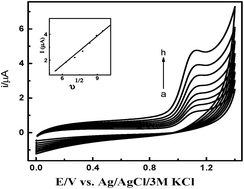A halofuginone electrochemical sensor based on a molecularly imprinted polypyrrole coated glassy carbon electrode†
Abstract
In this work, a novel and selective polypyrrole (PPy) electropolymerized molecularly imprinted electrochemical sensor (PPy-MIP) for halofuginone (HFG) determination was developed. The imprinted film was fabricated by electropolymerization of pyrrole (Py) in the presence of halofuginone (HFG) onto a glassy carbon electrode (GCE) surface. The electrochemical sensor exhibits a remarkable sensitivity, which might be due to the plenty of cavities for binding HFG through π–π stacking between aromatic rings and hydrogen bonds between nitrogen and oxygen-containing groups of HFG and PPy. Cyclic voltammetry (CV) and electrochemical impedance spectroscopy (EIS) were employed to characterize the constructed sensor. The effects of pH, the monomer concentration, the number of cycles for the electropolymerization, and the scan rate for the sensor preparation were optimized. Under the optimal conditions, the DPV peak current was linear to the HFG concentration in the range from 7.5 × 10−9 to 1.0 × 10−5 M, with a detection limit of 2.5 × 10−9 M. The prepared sensor also showed acceptable storage stability, reproducibility and regeneration capacity. The electrochemical sensor was applied to determine HFG in chicken meat samples with satisfactory results.


 Please wait while we load your content...
Please wait while we load your content...